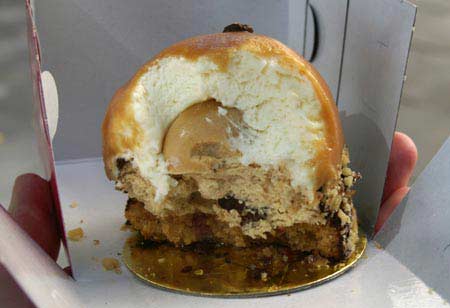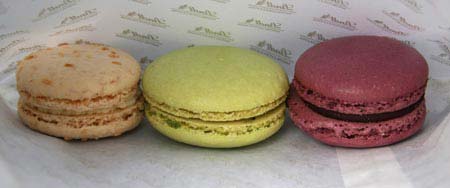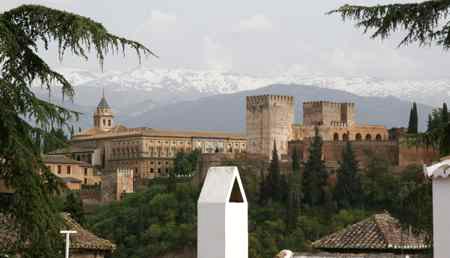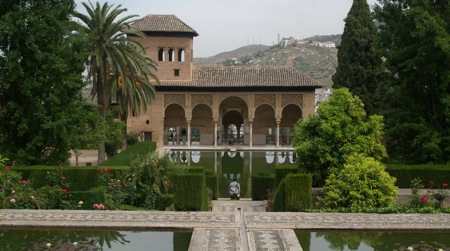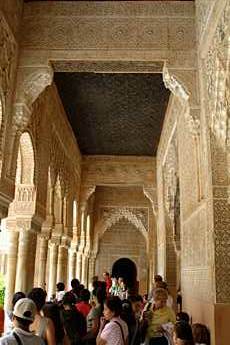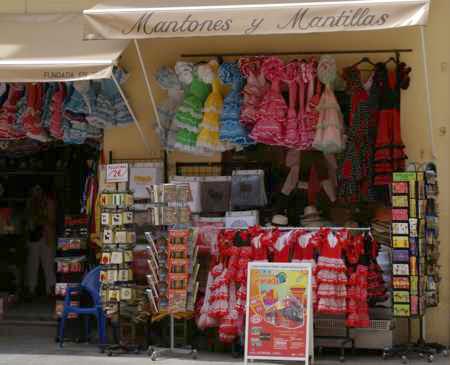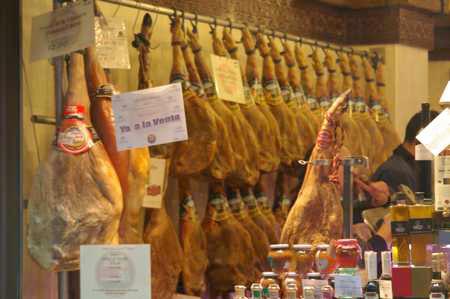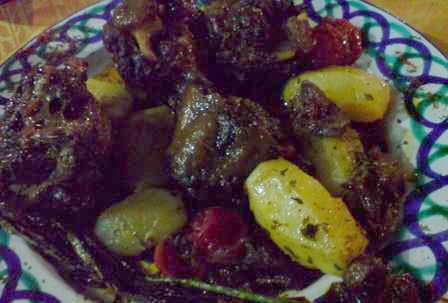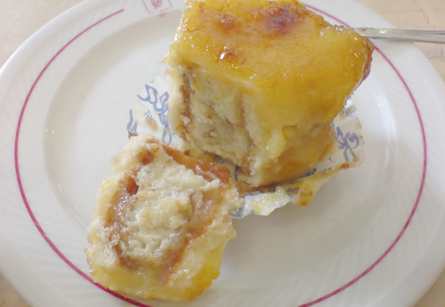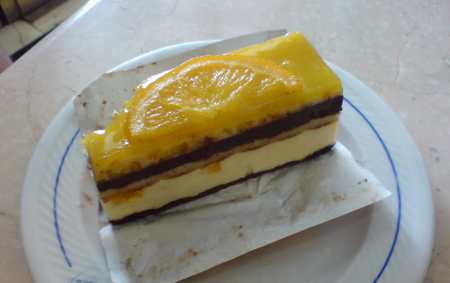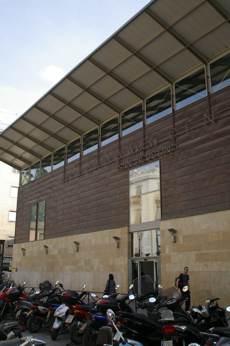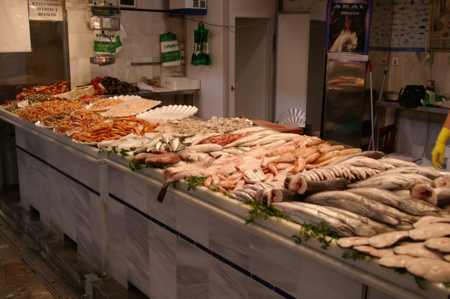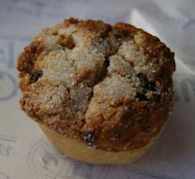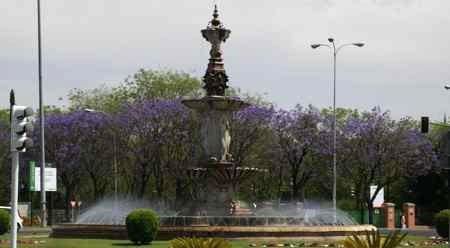
[Lots of photos here, so I’ve compressed them more than usual, with a loss of quality.]
A real city at last. Sevilla throbs with life. As the days have passed, I’ve felt the city-dweller in me yearning for a little more buzz than Córdoba or Granada could offer. The bus pulls in to the estación de autobuses Prado de San Sebastián. It’s a more modest building than expected and showing its age. I wander, somewhat directionless, out onto the street. The bus station is hidden behind a corner of a major intersection. I’d like to say it’s the southeast corner, but that Spanish habit of rotating maps makes it hard to be sure. The city is lush with enormous, blooming jacarandas. Beautiful violet blossom seems to light up the streetscape.
On the opposite side of the intersection is an enclosed garden. This runs in a narrow strip beside the walls of Sevilla’s Moorish/Mudéjar attraction, the Alcázar. Behind this wall hides a garden of considerably greater beauty. It’s warm, perhaps 30C. My garden is lovely but humid, and my backpack presses against an increasingly damp t-shirt. I emerge at the end of the garden into a small square and see the first evidence that Sevilla is indeed home to oranges.
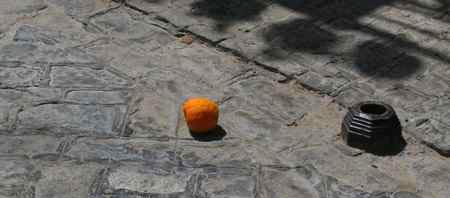
Seville oranges are large, heavy and fragrant. Rarely seen in Australia, they are the orange typically used for making marmelade. Australian marmelade makers know where to find them…
I plunge into the narrow lanes of this city, navigating my way towards my hotel. Behind an old brick façade there’s a flamenco, um, theatre(?) and the Hotel Alcántara, a throughly modern building. The lobby is heaving with elderly Americans. My room is on the top floor, looking down on an unremarkable inner courtyard and situated much too far from the free WiFi signal. The hotel is clean and comfortable, and the staff are friendly and somewhat bilingual. As with most hotels in Sevilla, it’s booked out months in advance. I sit in the lobby, where the WiFi is strongest, and witness bedraggled tourists asking in vain for a room.
It’s mid-afternoon and it’ll be some time before I can meet my local friend. I wander the streets close to the hotel, remembering quickly that I’d better not be reincarnated as a pigeon, because my geomagnetic sensitivity sucks. Curving streets. Lost. Bloody Spanish maps.
The streets are truly lined with orange trees and the gutters and parks are littered with burst, fermenting fruit. A homeless man watches as I forage amongst the fallen oranges for an intact one. He probably thinks I’m a stupid tourist who’ll try to eat it.
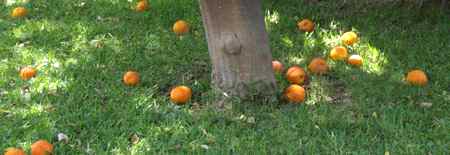
I rest for a coffee in a dark bar on a wide avenue beside the university. In a display case against the wall are a range of lunch dishes. Lobster crêpes, a chicken stew of some sort, some pasta. The bar is quite full, primarily with groups of businessmen. One man, sartorially perfect and complete with waxed moustache, receives a small plate entirely covered by a single, enormous slice of grilled pork sirloin. ‘Piggy’, I think to myself. He cuts this solomillo into many bitesize pieces and turns to offer the plate to his companions. I retract my ‘piggy’.
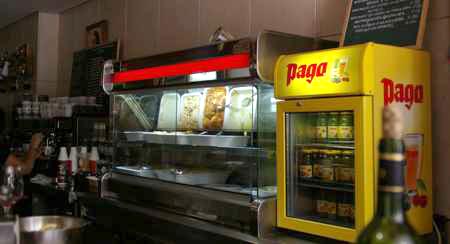
The coffee isn’t bad. I’ve learnt to order an americano con leche in Spain. It’s an espresso shot, lengthened with hot water, and with a little milk added. The milk is invariably UHT. I hate that. Previous visits to Spain have left me very unimpressed by the coffee. At least in Andalucía, it seems better this time. I pay and leave. The transaction is brusque. Coffee life isn’t warm here.
At 7pm, a little before twilight, I meet Javier, my local friend, a real hispalense or sevillano. We explore the park site of the 1929 Exposición Iberoamericana (the Plaza de España is pictured below) and then go into the centre of the city to wander around the streets near the cathedral (the largest Gothic church in the world) and the Alcázar before finding dinner somewhere.

Javier chooses a popular tapas bar called Pepe Hillo. We’re quite early, so most of the high benches and stools are free. He orders for us. Patatas bravas (fried potato with tomato sauce), solomillo al whisky (slices of pork with a tart whisky sauce), salmorejo (Córdoba-style gazpacho), and pechuga de pollo con ciruela (chicken fillet with a plum sauce). Amusingly, almost every dish is accompanied by chips. Simple. Delicious. Each dish costs no more than EUR 2.50.
We wander further, until I eventually decide dessert and coffee are needed. A pastelería on the Avenida de la Constitución — Horno de San Buenaventura — opposite the cathedral, has a lot to offer. The cakes are creamy, too much so. A millefeuille with pinenuts looks more promising. I notice a granizada machine and my coffee craving is replaced by lemony-ice lust. Granizada (called granizado in much of the rest of Spain) is a coarse type of granita, with large ice crystals and liquid consistency. Delicious. I’d like a direct connection to the granizada machine!
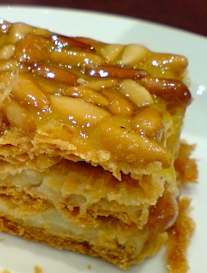

Later, we sit and watch a flamenco dancer in an old coal merchants’ warehouse. La Carbonería is jam-packed with tourists, but isn’t one of the tacky flamenco traps about which the guidebooks warn tourists. We drink tinto de verano, red wine diluted with lemon softdrink served with ice, a popular summer drink which is refreshing and light.
The next morning I decide to try my churros luck one more time in Spain. (I forgot to mention an awful, greasy, foul experience in my report on Córdoba.) A few streets from the hotel is a small churrería. You buy your churros (or other healthy fare like potato crisps in huge bags, or fried almonds) and can sit at the tables of the adjacent cafés. The guy serving is surprisingly friendly for Spain! He hands me a paper bundle and a polystyrene cup of hot chocolate. I unfold my bundle, finding this a little too reminiscent of fish and chips, and lo! there are lovely little horseshoes of churros, fresh and crisp. The chocolate is runny, but the taste of UHT milk is only faintly discernible.
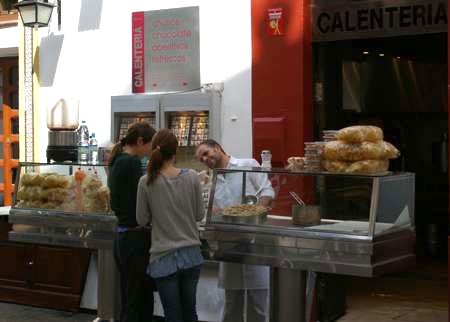


As I sit dipping my churros in the slightly too thin chocolate, I watch an elderly lady and her son receive a glass of hot milk each, then add a sachet of instant coffee. What?! Instant coffee? Javier tells me later that it’s a common way of serving decaffeinated coffee – decaf Nescafé for breakfast.
I discover that the queues to enter the cathedral and the Alcázar are depressingly long. I go exploring elsewhere instead. On the southern(?) bank of the Guadalquivir river is the Triana district, traditional home to the city’s gypsies. Here I find a fresh produce market, teeming with locals and with a wide range of vendors. One fruit and vegetable stall has a stunning diversity of produce, including numerous mushrooms and fresh herbs. Sometimes, just sometimes, there are reminders that Melburnians’ pride about the various markets in Melbourne is not always justified.
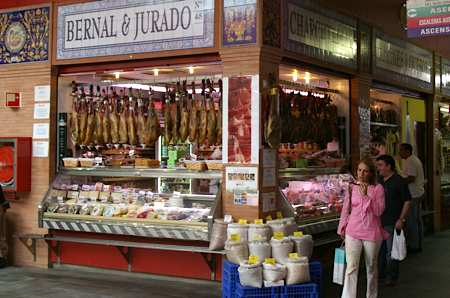
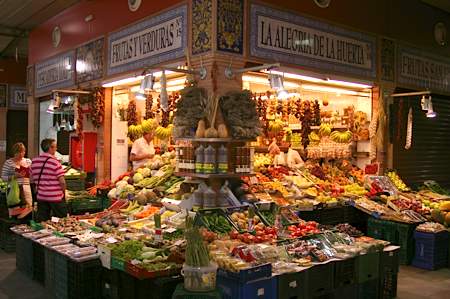
In the afternoon I do indeed manage to enter the Alcázar without queuing for more than a few minutes. The site map is impenetrable and signage in the rooms and buildings is minimal. The Spanish don’t just rotate maps willynilly – they also have little skill at visual communication (something I forgot to mention about the largely unsignposted Alhambra in Granada).
The Alcázar is my third Moorish site of this trip and the risk of Moor-fatigue is high. It is a complex of buildings which developed from an original palace. At first I feel a wave of ho-hum wash over me as familiar tile and stucco motifs return. Thankfully, however, the complexity of the buildings and the beauty of the gardens stir me from my sightseeing indifference. A stunning exhibition of Islamic calligraphy also has me in awe – and simultaneously frustrated that photography is forbidden. The book accompanying the exhibition is attractive, but its photos somehow lose the three dimensional glory of the royal writs, seals, books and scrolls.
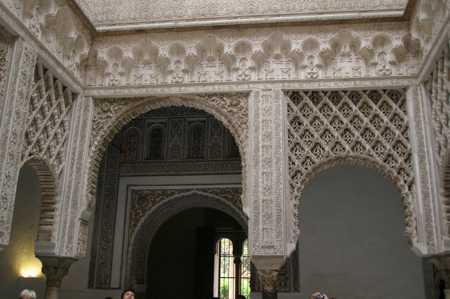
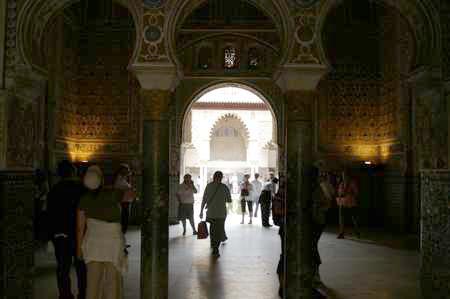

The cathedral is a let-down. My EUR7.50 entry fee fails to give me access to the primary attraction – the Giralda tower, originally a minaret – due to some event being held in it, and I find many of the cathedral’s columns swathed in scaffolding. Grrr.

This evening, Javier shows me a square (Plaza del Salvador) where Sevilla’s moneyed crowd gathers to drink on many a summer evening. Drinkers squeeze in and out of bars to get their beer. The atmosphere is warm and festive.

We also go searching for almonds. Not any little nuts, but the famed Marcona almonds, de rigeur with famous pastry chefs for some time. Allegedly from Spain, purportedly the almond non plus ultra. That’s nice. Pity that your average Spaniard hasn’t a clue what they are. Asking around in a few semillerías (a kind of edible seed and nut shop) draws all but one blank. The last shop has a bag of mixed fried nuts which included some Marconas. So while the chefs might rave about these, it seems they aren’t high on the common cook’s radar. A trip to the upmarket department store El Corte Inglés yields a bag of raw, blanched Marconas and Duncan is happy (notwithstanding a kilo price of EUR 20 – about A$35). These almonds are sort of broad and stubby. They are noticeably sweeter than the almonds we usually see.
We eat late, about 10pm, in a pokey little restaurant on the northern(?) outskirts of the city centre. The Antigua Abacería de San Lorenzo serves as a jack-of-all-trades place, selling bread and charcuterie to shoppers and simultaneously feeding hordes of hungry locals, squashed into small alcoves. We sit in a dark, raised nook, slightly behind the ice-cream chest. The two staff are friendly but harried, rushing to and fro and sometimes overlooking the two hungry fellas. The menu is interesting and more innovative than the typical places in Sevilla. Prices are higher than these places, but still markedly cheaper than a number of tapas bars I can think of in Melbourne for the same or superior quality. Is further comment necessary?
We order a fig and fresh cheese salad, sprinkled with cinnamon. Four (relatively) thick slices of jamón ibérico de bellota (from acorn-fed piggies) rest on some soft bread. The jamón almost melts on the tongue. Its creamy fat smears in the mouth in a way I’ve never experienced before. It’s an unusual sensation, not completely pleasant, but perhaps a signature of some of the finest jamón to be had.
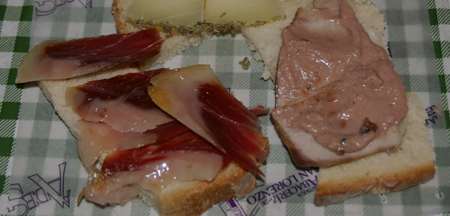

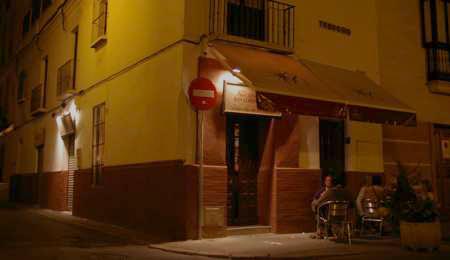
The olives are home-cured and excellent. A plate of huevos revueltos con chorizo looks frighteningly like a digestive mistake, but tastes fantastic. Scrambled egg with chorizo may well become my next comfort food!
I spend the following day shopping and exploring. Getting lost. Finding myself. Etc. I seek lunch at the pastelería of the first evening. The menu of bocadillos is a curious mix of boringness. I’m beginning to crave vegetables. Not much hope here. In awful Spanish, I try to ask for a sandwich with jamón serrano (more run of the mill than ibérico, and markedly cheaper), tomato and cheese. Oh my, how difficult. It’s as if I’ve asked for the sun and the earth. They have serrano. I can see it hanging there. They have cheese. They have tomatoes. It’s not on the menu. The waitress and the ham-man go into conference. Eventually I have a lovely bocadillo, as requested, replete with a garnish of potato crisps (and I thought it was only the British that need a bag of crisps with their lunch!).

Spanish cakes are rather sweet. I haven’t succeeded in getting my head around the principles of cake composition. There can be lots of cream. Lots of sweet, fatty or fruity mousse. Lots of lard-based pastry and biscuits. Lots of preserved citron, grated and used as a filling. I don’t see much evidence of a balancing of flavours or textures. There seems to be no drive to mix crunch with squidge or sweet with sour. Despite rich displays of cakes, I find myself unenthusiastic about an afternoon sweet.
Dinner is at a popular tapas bar called Coloniales (I think there are two branches in the city). It’s crammed with people, mostly youngish locals. We find a 30cm space at the bar and eventually procure a menu. Salmorejo spread on bread, topped with jamón. Heaven. Gimme more. Spinach and cheese croquettes. A vegetable!! Crumbed, fried capsicum with salmorejo. Goat’s cheese and dried fig on toast.
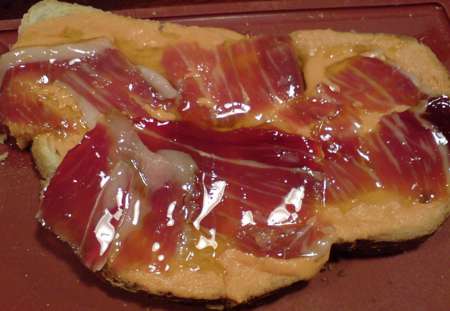
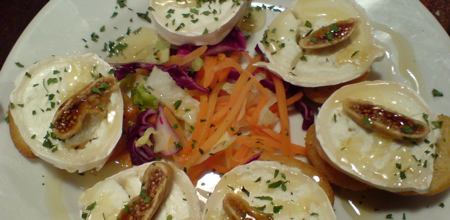
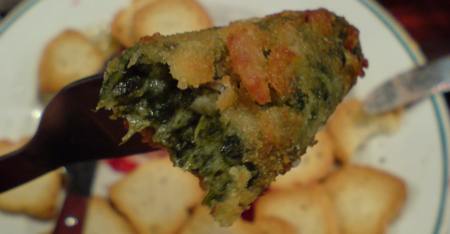

I’ve had three great dinners, each showing a different aspect of this style of food. The first was simple and everyday, the second somewhat creative and of high quality, the third more conventional but perfectly produced. The cheapest tapa was EUR 1.30, the most expensive ración we ate was EUR 6.00 (approx A$10). You can certainly go higher, especially for fish or in upmarket or more innovative places.
The next morning I leave Sevilla for Portugal. The airport bus is slightly mysterious. The website timetable is misleading. Hotel staff disagree about where the bus-stop is. I learned long ago not to trust every local’s instructions when it comes to such things. You either check these things yourself, or allow time for the instructions to be wrong. I find the bus-stop, close to the third location suggested to me at the hotel.
The bus takes a long, circuitous route to the airport, then dumping passengers in a carpark some distance from the terminal. The airport is small (11 gates) and check-in is slow, as so often in southern Europe. I board a tiny Portugalia jet bound for Lisbon. They serve a cheese and ham roll which is smaller than a tennis ball.
Travel tips
Eating tapas: Eating at bars can be daunting here, as regulars and others throng in the narrow passages between walls and bar, perching in window alcoves, sliding off the paucity of bar stools or snaffling one of the few tables inside or out. The locals know how to order. The tourists often don’t. Confronted with rapid-fire ordering, frequently in a local accent that bears tenuous similarity to anything you might have heard on telly or learnt in school, it’s easy to wish for a 7-Eleven and an easy life. But, thankfully, there aren’t any 7-Elevens, so it’s do or die. Find a free space at the bar if you can, or accept that you’ll nurse your tapa in your hand amidst the throng. Pray for a menu. Don’t look scared. Take a deep breath. Call out an order for a drink so the waiter registers your existence. Pray for a menu. On lucky days, you might be surprised to find the menu in a seemingly locals-only place is in English too. The Spanish so rarely speak much English, but the number of multilingual menus is helpful. Order a few things. You’ll probably need to say what size (tapa, medio-ración, ración) but how much it will end up being is unpredictable. Some tapas are quite filling, others modest. There’s nothing stopping you from ordering more later.





